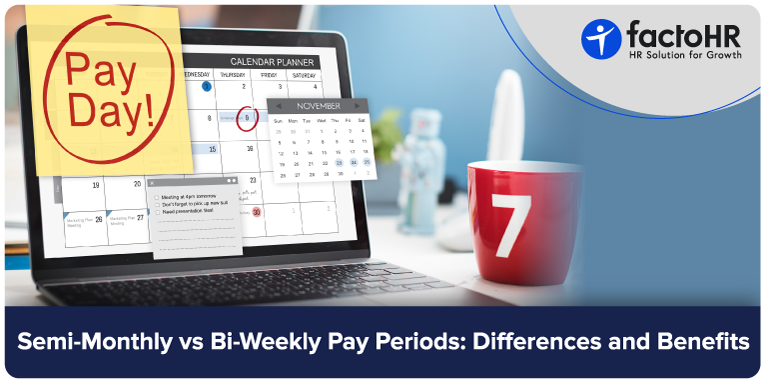Bi-Weekly vs Semi-Monthly Pay Periods: Key Differences and Benefits

Table of Contents
Your payroll schedule plays an important role in your financial planning and can improve your business operations! The payroll schedule is a predetermined interval that dictates how often employees receive their paychecks.
Employers have the flexibility to choose from several pay period options, including monthly, semi-monthly, or biweekly pay schedules. Semi-monthly and bi-weekly pay schedules are the most popular, but understanding the difference can be confusing.
Choosing the right pay schedule is crucial for both companies and employees, as it enables employers to manage their cash flow effectively and empowers employees to budget efficiently.
Whether you’re determining a pay schedule for a new business or considering changes in the existing pay cycle, this article will explore various types of pay schedules. It also covers the variations in salary cycles and the elements that affect a company’s selected pay schedule.

What is a Pay Schedule?
A pay schedule is the set time frame that determines when employees receive their payments for their work. It is calculated by tracking an employee’s work hours. Every payroll has a different start and end date, and these periods are seamlessly connected, guaranteeing a consistent flow of income.
The frequency of pay periods may vary from company to company. Typically, the company offers pay schedules that include weekly, bi-weekly, semi-monthly, or monthly payments. The pay schedule typically depends on the employer and the job role within the organization.
What is Bi-Weekly Pay?
Bi-weekly pay involves receiving paychecks every other week, usually on a designated weekday. For example, Friday is a payday, which means workers receive their paychecks every other Friday.
A bi-weekly pay schedule results in two paychecks per month. The total number of paychecks received over a year will be 26, as 2 months of the year will have 3 pay schedules. According to a BLS survey, this pay schedule is the most common in the private sector, with 43% of companies in the U.S. paying their employees bi-weekly.
Pros and Cons of Bi-Weekly Pay Schedules
Pros
- Bi-weekly pay offers greater flexibility for those with irregular workdays, providing a regular payday every other week.
- Employees can plan their weekly or regular purchases more effectively.
- Receiving payments more often can make it easier to save money, mainly when an employee gets an “extra” paycheck. For individuals managing their finances on a month-to-month basis, a month with three paychecks can feel like a bonus.
Cons
- A bi-weekly pay schedule may increase the administrative workload on HR and the payroll team, as they will have to process payroll more frequently.
- Cash flow is biweekly and sometimes three times a month, which can cause cash flow issues, inconsistent expenses, increased payroll costs, and budgeting challenges, ultimately impacting cash reserves.
- Employees’ annual earnings will remain the same, but they may receive smaller paychecks during the three-paycheck months.

What is Semi-Monthly Pay?
A semi-monthly pay schedule pays employees twice a month, resulting in a total of 24 paychecks per year. Typically, paydays are scheduled on specific dates, such as the 1st, 15th, or last day of the month.
Semi-monthly payroll may be an excellent choice for organizations that offer employee benefits deductions, such as health insurance and retirement contributions. Paydays align with monthly financial reporting, simplify deductions, and report deductions from employees’ paychecks.
The core difference between semi-monthly vs bi-weekly pay periods is the fixed schedule – payments are made on specific dates of every month.
Pros and Cons of Semi-Monthly Pay Schedules
Pros
- Fewer pay schedules reduce the administrative burden, as they save time on payroll processing and make the management of benefit deductions easier.
- It’s easier to calculate salaries as they are spread evenly throughout the year on fixed dates, allowing employees and employers to plan their finances.
- Employees will receive more payments compared to those paid bi-weekly.
Cons
- The gap between paychecks may be longer, as some months employees might feel a strain on cash flow due to waiting up to 16 days for a paycheck. This can create challenges with budgeting, particularly in emergencies.
- A semi-monthly pay schedule complicates the calculation and tracking of overtime for employees paid hourly, particularly when their weekly work hours vary.
- HR and payroll teams need to track the pay date; if payday falls on a weekend or holiday, they must ensure that the payroll process is completed in advance to avoid any delays.

Key Differences Between Bi-Weekly and Semi-Monthly Pay Schedules
| Aspect | Bi-weekly Pay Schedules | Semi-monthly Pay Schedules |
|---|---|---|
| Definition | Employees are paid every other Friday. | Employees are paid twice a month on particular dates, generally on the 1st and 15th, or the 15th and 30th. |
| Paychecks per Year | 26 paychecks in a year (as 2 months of the year will have 3 pay periods). | 24 paychecks per year. |
| Payday Consistency | Payday is consistent, as it occurs on the same day of the week every month. | Payday may vary and fall on a weekend or a holiday, leading to early or late payments. |
| Paycheck Amount | A smaller paycheck amount during the three-paycheck months. | Higher paycheck amount. |
| Payroll Processing | More frequent payroll processes. | Less frequent payroll processes. |
| Overtime Calculation | Overtime calculation is easy. | Overtime calculation is complex. |
| Alignment with Expenses | Aligns with weekly expenses. | Aligns with monthly expenses. |
| Cash Flow Impact | Inconsistent, as two months will have three paychecks. | Consistent cash flow. |
| Employee Preference | Preferred for regularity and consistency. | Good for those who plan a monthly budget. |
| Compliance Considerations | Must ensure compliance with labour laws for minimum wage and overtime on a pay-per-day basis. | Similar compliance requirements. |
| Annual Salary Calculation | Payroll calculation is challenging due to the pay schedules. | Payroll calculation is simple. |
Semi-Monthly vs Bi-Weekly Pay Schedule: Which Pay Schedule is Better?
A semi-monthly payschedule requires less payroll processing compared to a bi-weekly payschedule. Since payroll processing is done on a fixed date, many companies may choose a semi-monthly pay schedule. However, select the pay period that works for your company based on its payroll policies, cash flow, and the labor laws of the region where your company operates.
Other Pay Schedules
Efficiency starts with a payroll cycle that works for you. Before selecting the pay schedule that best suits you, consider the following options.
Monthly: In a monthly pay schedule, employees receive their salaries once per month on a specified date, resulting in a total of 12 paychecks annually. This is the most cost-effective option for employers. However, employees must wait an entire month to get their paycheck.
Weekly: Weekly pay schedules mean employees are paid every week, requiring 52 paychecks to be processed per year, which can be expensive and time-consuming for employers. However, this pay period works best for freelancers or contract-based employees who are paid on an hourly basis.
Semi-weekly: In this pay schedule, employees are compensated twice a week, depending on the company’s payroll policies. As this pay schedule requires frequent payroll processing, it increases the administrative burden on HR and payroll teams.

Conclusion
Semi-monthly and bi-weekly pay schedules have their advantages and drawbacks. Semi-monthly pay schedules, with their fixed dates and fewer payroll runs, can benefit salaried workers and simplify cash flow management for companies. Semi-monthly payments may not be suitable for hourly, contract, or freelance employees, as they are typically compensated based on the hours worked.
Bi-weekly pay, with its fixed payday, can be beneficial for employees working on an hourly basis. Semi-monthly and bi-weekly pay schedules are the most common pay schedules. Both options are excellent, and the choice you make depends on factors like industry, company size, type of employee, and payroll regulations in your region. Ultimately, the best option depends on the particular needs and circumstances of the company and its employees. You can also use factoHR’s payroll software to ease payroll processing.
Confused about which pay schedule to choose for your company? Schedule a demo today!
Grow your business with factoHR today
Focus on the significant decision-making tasks, transfer all your common repetitive HR tasks to factoHR and see the things falling into their place.

© 2026 Copyright factoHR


